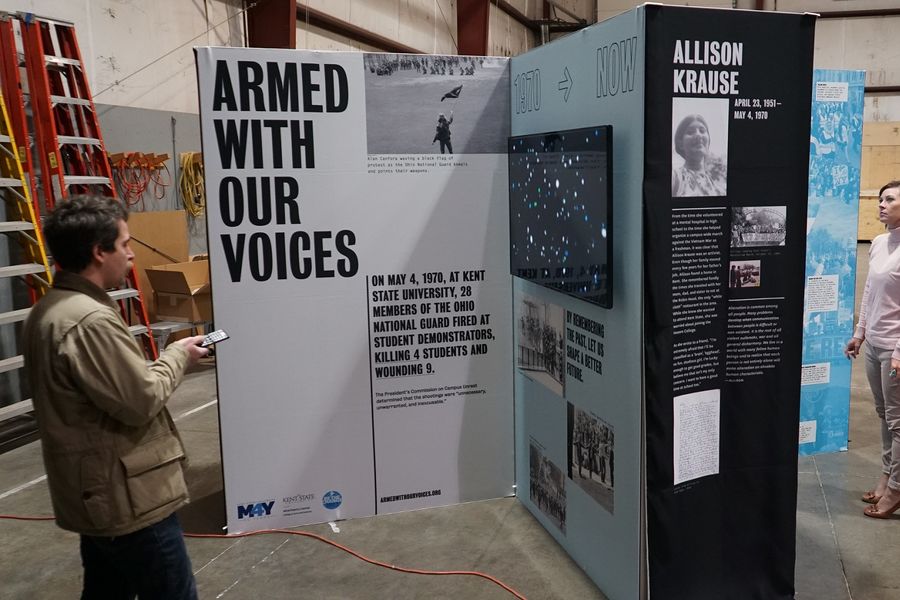May 4 50

Exhibit Showcases May 4 Artifacts in Augmented Reality
Artifacts of May 4, 1970 – a survivor’s jacket, a gas mask and gun shell casing – tell a story that’s not often accessible to the general public. Assistant Professor Abe Avnisan and students in his digital sciences capstone course will bring these artifacts’ stories to life via the exhibit “May 4: Through the Looking Glass.”

Kent State’s Wick Poetry Center to Debut National Interactive Exhibit in Support of 50th Commemoration of May 4
Kent State University’s Wick Poetry Center is set to debut its “Armed With Our Voices” exhibit this week in Austin, Texas, as part of the National Council for the Social Studies annual conference. The exhibit provides a powerful form of cross-generational connection that engages users in the events of May 4, 1970, and the importance of peace, conflict resolution and student activism today.

Educator's Summit on May 4 Has Great Success; National Grant Will Allow Program to Grow in 2020
Organizers of the recent Voices for Change Educator’s Summit at Kent State University say the curriculum developed at the event can be used by teachers worldwide, so that the lessons of May 4, 1970, will continue to be shared. The summit, held in August, was one about 100 events planned for the 2019-20 academic year to support the 50th commemoration of May 4, 1970, the day when Ohio National Guardsmen opened fire on Kent State students protesting the U.S. invasion of Cambodia during the Vietnam War, killing four and wounding nine.

Kent State’s May 4 Visitors Center Honors May 4 Victim Jeffrey Miller With New Exhibition
Guests of Kent State University’s May 4 Visitors Center can learn more about Jeffrey Miller, one of the four students shot and killed by the Ohio National Guard on May 4, 1970, by visiting “Our Brother Jeff,” a new exhibition at the visitors center that honors Miller’s life. The exhibition will be on display from Oct. 19, 2019, to Feb. 29, 2020. Russ Miller, Jeff’s brother, helped create the exhibition by loaning some of Jeff’s personal items to the May 4 Visitors Center.

America’s ‘Top Turnaround Mayor’ to Speak at Kent State on Nov. 19
Mitch Landrieu, the New Orleans mayor who oversaw the removal of the city’s prominent Confederate monuments and helped his city to recover and reemerge from a series of natural disasters, will speak at Kent State as part of the university’s May 4 Speaker Series.

Kent State University Course to Educate Community About May 4, 1970
Kent State University is offering a community course that deals with the historical, cultural, social and political contexts of events before, during and after the May 4, 1970, shootings. The free course, Making Meaning of May 4: The Kent State Shootings in American History, will be held Oct. 16, 23 and 30 at the university’s May 4 Visitors Center.

Kent State Nursing Alumna Reflects on May 4 Tragedy
In the spring of 1970, two-time Kent State University alumna and registered nurse Pat Gless was a junior in Kent State’s inaugural nursing program. While in class on Monday, May 4, a professor rushed into her classroom and warned students who could leave campus to do so. Fifty years later, Gless now reflects on the events surrounding that tragedy and how they have impacted her life and nursing career.

Photos from May 4, 1970, Resurrected in New Book by Kent State Alumnus
On the morning of May 4, 1970, Kent State University student Howard Ruffner was hanging out in the office of the Daily Kent Stater in Taylor Hall when the phone rang.
The Midwest editor from Life magazine, based in Chicago, was calling to find out if there were any student photographers who had been taking photos over the weekend. Kent State had been the scene of student protests for several days, and more demonstrations were expected that day.

'Wearing Justice' Exhibition at Kent State University Museum Brings Attention to Global Social Issues
In commemoration of the 50th anniversary of May 4, 1970, when Ohio National Guardsmen opened fire on Kent State University students protesting the U.S. invasion of Cambodia during the Vietnam War, killing four and wounding nine, students and faculty from Kent State’s School of Fashion Design and Merchandising are bringing attention to current social issues in the new exhibition called “Wearing Justice: Perspectives From KSU Fashion School Faculty and Students” that is on display now at the Kent State University Museum.

By the Book: Recommended Reading on May 4, 1970
Plenty has been written about May 4, 1970. Ken Burhanna, dean of Kent State University Libraries, offers his preferred reading list.